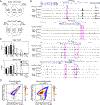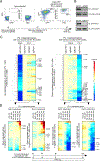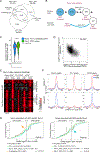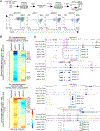Transcription Factor PU.1 Represses and Activates Gene Expression in Early T Cells by Redirecting Partner Transcription Factor Binding
- PMID: 29924977
- PMCID: PMC6063530
- DOI: 10.1016/j.immuni.2018.04.024
Transcription Factor PU.1 Represses and Activates Gene Expression in Early T Cells by Redirecting Partner Transcription Factor Binding
Erratum in
-
Transcription Factor PU.1 Represses and Activates Gene Expression in Early T Cells by Redirecting Partner Transcription Factor Binding.Immunity. 2018 Oct 16;49(4):782. doi: 10.1016/j.immuni.2018.09.019. Immunity. 2018. PMID: 30332634 Free PMC article. No abstract available.
Abstract
Transcription factors normally regulate gene expression through their action at sites where they bind to DNA. However, the balance of activating and repressive functions that a transcription factor can mediate is not completely understood. Here, we showed that the transcription factor PU.1 regulated gene expression in early T cell development both by recruiting partner transcription factors to its own binding sites and by depleting them from the binding sites that they preferred when PU.1 was absent. The removal of partner factors Satb1 and Runx1 occurred primarily from sites where PU.1 itself did not bind. Genes linked to sites of partner factor "theft" were enriched for genes that PU.1 represses despite lack of binding, both in a model cell line system and in normal T cell development. Thus, system-level competitive recruitment dynamics permit PU.1 to affect gene expression both through its own target sites and through action at a distance.
Keywords: DNA accessibility; Runx1; Satb1; Spi1; repression.
Copyright © 2018 Elsevier Inc. All rights reserved.
Figures







Comment in
-
Transcription Factor Theft-PU.1 Caught Red-Handed.Immunity. 2018 Jun 19;48(6):1063-1065. doi: 10.1016/j.immuni.2018.05.007. Immunity. 2018. PMID: 29924967
Similar articles
-
Stage-specific action of Runx1 and GATA3 controls silencing of PU.1 expression in mouse pro-T cells.J Exp Med. 2021 Aug 2;218(8):e20202648. doi: 10.1084/jem.20202648. Epub 2021 Jun 28. J Exp Med. 2021. PMID: 34180951 Free PMC article.
-
Runx1 promotes murine erythroid progenitor proliferation and inhibits differentiation by preventing Pu.1 downregulation.Proc Natl Acad Sci U S A. 2019 Sep 3;116(36):17841-17847. doi: 10.1073/pnas.1901122116. Epub 2019 Aug 20. Proc Natl Acad Sci U S A. 2019. PMID: 31431533 Free PMC article.
-
Transcription Factor Theft-PU.1 Caught Red-Handed.Immunity. 2018 Jun 19;48(6):1063-1065. doi: 10.1016/j.immuni.2018.05.007. Immunity. 2018. PMID: 29924967
-
Mechanisms of Action of Hematopoietic Transcription Factor PU.1 in Initiation of T-Cell Development.Front Immunol. 2019 Feb 20;10:228. doi: 10.3389/fimmu.2019.00228. eCollection 2019. Front Immunol. 2019. PMID: 30842770 Free PMC article. Review.
-
At the crossroads: diverse roles of early thymocyte transcriptional regulators.Immunol Rev. 2006 Feb;209:191-211. doi: 10.1111/j.0105-2896.2006.00352.x. Immunol Rev. 2006. PMID: 16448544 Review.
Cited by
-
Bcl11b sets pro-T cell fate by site-specific cofactor recruitment and by repressing Id2 and Zbtb16.Nat Immunol. 2018 Dec;19(12):1427-1440. doi: 10.1038/s41590-018-0238-4. Epub 2018 Oct 30. Nat Immunol. 2018. PMID: 30374131 Free PMC article.
-
EBF1 and PAX5 control pro-B cell expansion via opposing regulation of the Myc gene.Blood. 2021 Jun 3;137(22):3037-3049. doi: 10.1182/blood.2020009564. Blood. 2021. PMID: 33619557 Free PMC article.
-
SPaRTAN, a computational framework for linking cell-surface receptors to transcriptional regulators.Nucleic Acids Res. 2021 Sep 27;49(17):9633-9647. doi: 10.1093/nar/gkab745. Nucleic Acids Res. 2021. PMID: 34500467 Free PMC article.
-
How transcription factors drive choice of the T cell fate.Nat Rev Immunol. 2021 Mar;21(3):162-176. doi: 10.1038/s41577-020-00426-6. Epub 2020 Sep 11. Nat Rev Immunol. 2021. PMID: 32918063 Free PMC article. Review.
-
Multi-modular structure of the gene regulatory network for specification and commitment of murine T cells.Front Immunol. 2023 Jan 31;14:1108368. doi: 10.3389/fimmu.2023.1108368. eCollection 2023. Front Immunol. 2023. PMID: 36817475 Free PMC article. Review.
References
-
- Cai Z, de Bruijn M, Ma X, Dortland B, Luteijn T, Downing RJ, and Dzierzak E. (2000). Haploinsufficiency of AML1 affects the temporal and spatial generation of hematopoietic stem cells in the mouse embryo. Immunity 13, 423-431. - PubMed
Publication types
MeSH terms
Substances
Grants and funding
LinkOut - more resources
Full Text Sources
Other Literature Sources
Molecular Biology Databases
Research Materials

